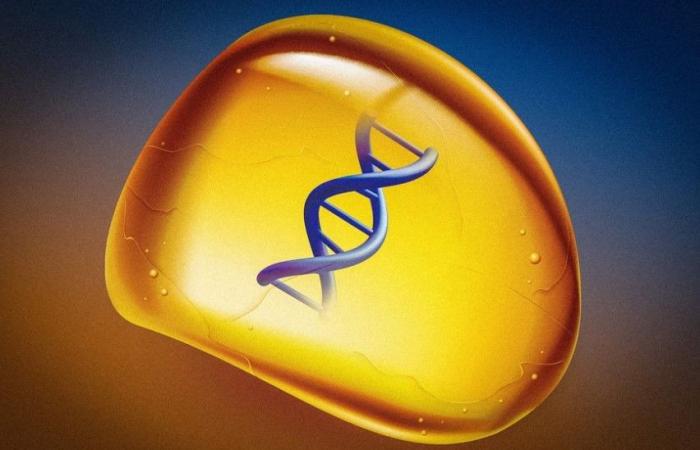Researchers at MIT have developed an amber-like glassy polymer that can be used to store DNA long-term, whether complete human genomes or digital files like photographs.
Most current methods for storing DNA require freezing temperatures, so they consume a lot of energy and are not feasible in many parts of the world. Instead, the new amber-like polymer can store DNA at room temperature while protecting the molecules from damage caused by heat or water.
The researchers showed that they could use this polymer to store DNA sequences that encode the music from Jurassic Park, as well as an entire human genome. They also showed that DNA can be easily extracted from the polymer without damaging it.
“Freezing DNA is the number one way to preserve it, but it is very expensive and not scalable,” James Banal, a former MIT postdoctoral researcher, says in a statement. “I believe that our new preservation method is going to be a technology that can drive the future of digital information storage in DNA,” added the lead author of the study, published in the Journal of the American Chemical Society.
A very stable molecule, DNA is well suited for storing massive amounts of information, including digital data. Digital storage systems encode text, photos, and other information as a series of 0s and 1s. This same information can be encoded in DNA using the four nucleotides that make up the genetic code: A, T, G, and C. For example, G and C could be used to represent 0, while A and T represent 1.
DNA offers a way to store this digital information at very high density: in theory, a coffee cup full of DNA could store all the data in the world. DNA is also very stable and relatively easy to synthesize and sequence.
In 2021, Banal and his postdoctoral advisor, Mark Bathe, a professor of biological engineering at MIT, developed a way to store DNA in silica particles, which could be labeled with tags that would reveal the contents of the particles. That work led to a spin-off company called Cache DNA.
A disadvantage of that storage system is that it takes several days to embed the DNA in the silica particles. Additionally, extracting DNA from the particles requires hydrofluoric acid, which can be dangerous for workers handling the DNA.
To come up with alternative storage materials, Banal began working with Johnson and members of his lab. His idea was to use a type of polymer known as a degradable thermoset, which consists of polymers that form a solid when heated. The material also includes cleavable bonds that can be easily broken, allowing the polymer to be degraded in a controlled manner.
“With these deconstructable thermosets, depending on the cleavable bonds we put in them, we can choose how we want to degrade them,” Johnson says.
For this project, the researchers decided to make their thermoset polymer from styrene and a cross-linker, which together form an amber-like thermoset called cross-linked polystyrene. This thermoset is also very hydrophobic, so it can prevent moisture from entering and damaging DNA. To make the thermoset degradable, the styrene monomers and cross-linkers are copolymerized with monomers called thionolactones. These bonds can be broken by treating them with a molecule called cysteamine.
Because styrene is so hydrophobic, researchers had to find a way to attract DNA (a negatively charged hydrophilic molecule) to styrene.
To do this, they identified a combination of three monomers that they could convert into polymers that dissolve DNA by helping it interact with styrene. Each of the monomers has different characteristics that cooperate to take the DNA out of the water and into the styrene. There, the DNA forms spherical complexes, with charged DNA in the center and hydrophobic groups that form an outer layer that interacts with the styrene. When heated, this solution turns into a solid glass-like block, embedded with DNA complexes.
EMBEDDING IN A FEW HOURS
The researchers called their method T-REX (thermohardener-enhanced xeropreservation). The process of embedding DNA into the polymer network takes a few hours, but that time could be shortened with further optimization, the researchers say.
To release the DNA, the researchers first add cysteamine, which breaks the bonds holding the polystyrene thermoset together, breaking it into smaller pieces. A detergent called SDS can then be added to remove the DNA from the polystyrene without damaging it.
Using these polymers, the researchers showed that they could encapsulate DNA of variable lengths, from dozens of nucleotides to an entire human genome (more than 50,000 base pairs). They were able to store DNA that encoded Lincoln’s Emancipation Proclamation and the MIT logo, as well as the background music from ‘Jurassic Park.’
After storing the DNA and then extracting it, the researchers sequenced it and found that no errors had been introduced, which is a fundamental characteristic of any digital data storage system.
The researchers also showed that the thermosetting polymer can protect DNA from temperatures up to 75 degrees Celsius. They are now working on ways to streamline the manufacturing process of the polymers and shape them into capsules for long-term storage.


